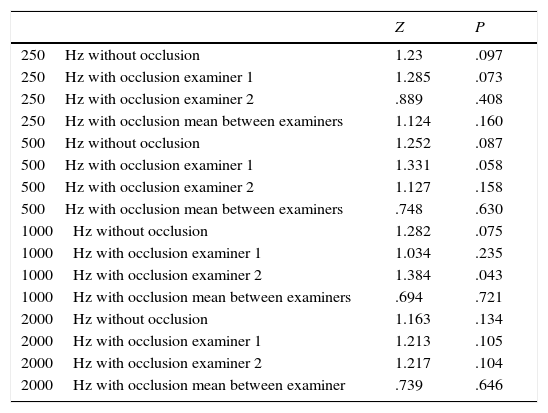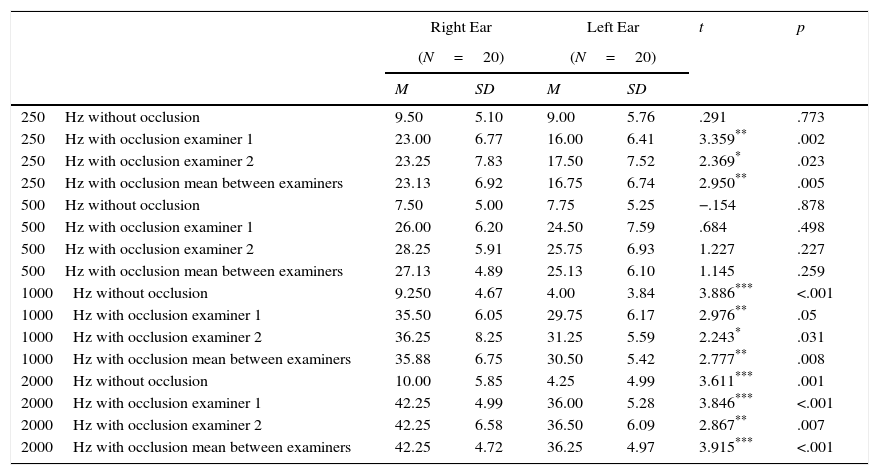Bedside testing with tuning forks may decrease turnaround time and improve decision making for a quick qualitative assessment of hearing loss. The purpose of this study was to quantify the effects of ear canal occlusion on hearing, in order to decide which tuning fork frequency is more appropriate to use for quantifying hearing loss with the Contralateral Occlusion Test.
MethodsTwenty normal-hearing adults (forty ears) underwent sound field pure tone audiometry with and without ear canal occlusion. Each ear was tested with the standard frequencies. The contralateral ear was suppressed with by masking. Ear occlusion was performed by two examiners.
ResultsParticipants aged between 21 and 30 years (25.6±3.03 years) showed an increase in hearing thresholds with increasing frequencies from 19.94dB (250Hz) to 39.25dB (2000Hz). The threshold difference between occluded and unoccluded conditions was statistically significant and increased from 10.69dB (250Hz) to 32.12dB (2000Hz). There were no statistically significant differences according to gender or between the examiners.
ConclusionThe occlusion effect increased the hearing thresholds and became more evident with higher frequencies. The occlusion method as performed demonstrated reproducibility. In the Contralateral Occlusion Test, 256Hz or 512Hz tuning forks should be used for diagnosis of mild hearing loss, and a 2048Hz tuning fork should be used for moderate hearing loss.
Las pruebas de cabecera realizadas con diapasón pueden reducir el tiempo de respuesta y mejorar la toma de decisiones en la evaluación rápida cualitativa de la hipoacusia. El objetivo de este estudio fue cuantificar los efectos de la oclusión del canal auditivo sobre la audición, a fin de decidir qué frecuencia de diapasón es más adecuado utilizar para cuantificar la hipoacusia con la prueba de oclusión contralateral.
MétodosVeinte adultos con audición normal (40 oídos) fueron sometidos a una audiometría de tonos puros, con y sin oclusión del conducto auditivo. Se realizó una prueba en cada oído, a las frecuencias estándar. El oído contralateral fue suprimido mediante enmascaramiento. La oclusión del oído fue realizada por parte de 2 examinadores.
ResultadosLos participantes de edades comprendidas entre 21 y 30 años (25,6±3,03 años) reflejaron un incremento de los umbrales auditivos con frecuencias ascendentes de 19,94dB (250Hz) a 39,25dB (2.000Hz). La diferencia de dicho umbral entre las situaciones de oclusión y no oclusión fue estadísticamente significativa, incrementándose de 10,69dB (250Hz) a 32,12dB (2.000Hz). No se produjeron diferencias estadísticamente significativas con arreglo al sexo, o entre los examinadores.
ConclusiónEl efecto de la oclusión incrementó los umbrales auditivos, siendo este hecho más evidente con frecuencias más elevadas. El método de oclusión realizado demostró la reproducibilidad. En la prueba de oclusión contralateral deberán utilizarse diapasones de 256 o 512Hz para el diagnóstico de la hipoacusia leve, y un diapasón de 2.048Hz para la hipoacusia moderada.











